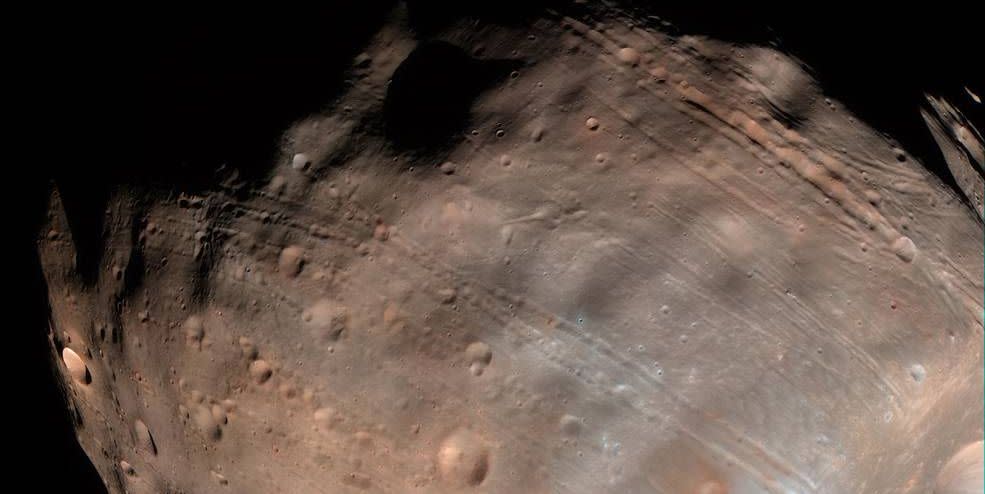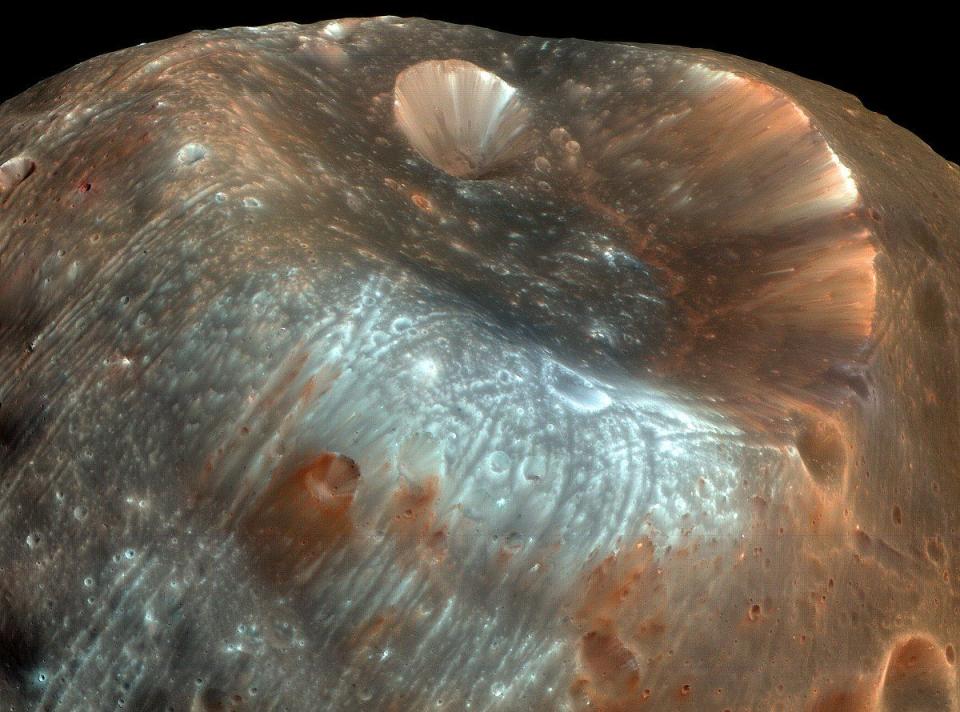Everything You Need to Know About Mars’s Mysterious Moons

- Oops!Something went wrong.Please try again later.
- Oops!Something went wrong.Please try again later.
The Red Planet has played an outsized role in the human imagination since its discovery in 1610.
In the 19th century, Giovanni Virginio Schiaparelli, the director of the Brera Observatory in Milan, sparked chaos after announcing that he had discovered a series of canals that he claimed were built by an undetected intelligent civilization. (Spoiler: these “canali” did not even exist!) And the famed science fiction author H.G. Wells envisioned it as home base to an alien race determined to conquer Earth.
Now, people on Earth (ahem, Elon Musk) see Mars as another potential tourist location, or even home. But for all its fame, the planet’s moons never get much credit. Here’s what you should know about them.
How Many Moons Does Mars Have?
Two: the larger, innermost moon, Phobos, and the smaller, outermost moon, Deimos. Perhaps one of the reasons they don’t draw headlines is that they’re among the solar system’s smallest moons. Phobos is just 17-by-14-by-11 miles in diameter, while Deimos is a puny 9-by-7-by-6.8 miles in size.
What Are Phobos and Deimos Like?
Phobos and Deimos are made out of what NASA designates as C-type rock, similar to blackish, carbonaceous chondrite asteroids. Since they’re both so small, they’re constantly orbiting around the Red Planet. Phobos circles Mars three times a day, while Deimos completes an orbit every 30 hours.
Neither moon fits the traditional spherical model for planetary bodies. Both are irregularly shaped and often compared to potatoes. Both have been smashed by asteroids and are littered with impact craters. Both are suspected to have been asteroids in a previous life, captured by Martian gravity, possibly from the nearby asteroid belt. Neither have the gravity to sustain any satellites of their own.
Do Mars’s Moons Have Any Distinguishing Features?
Between the two of them, there’s just one.
With a diameter of roughly 5.6 miles, Phobos’ largest crater, Stickney, takes up a significant part of the moon’s surface. The massive crater, pock-marked with a series of smaller craters inside, is large enough to be seen with the naked eye from the Martian surface. The story of how this cavernous crater got its name is a fascinating one.

The American astronomer Asaph Hall discovered Phobos and Deimos in 1877. Speculation about the planet’s moons had existed as far back as Galileo, and there’s an imagined reference to them in Jonathan Swift’s classic Gulliver’s Travels. At the time, Hall was working off an assumption that since the inner planets had no moons, Earth had one, and Jupiter had four, it stood to reason that a planet in between them would have two.
Hall had grown frustrated in his search, during which he had come close to identifying the moons, but had been hindered by bad weather. But his wife, the mathematician Angeline Hall, strongly encouraged him to continue. Like clockwork, Hall discovered Deimos on August 12, 1877, and found Phobos less than a week later, writing that he “might have abandoned the search [for Martian satellites] had it not been for the encouragement of [his] wife.”
Like many women historically involved in science, however, Angeline never received the credit she deserved in life. When she asked her husband for equal compensation for her work assisting him, he refused to give her a man’s wage. Low blow.
But discoveries made in space have a way of outlasting their discoverers. Flash forward to 1973, when NASA’s Mariner 9 discovered a large crater on Phobos. Carl Sagan, aware of the story of inequality between the Halls, offered a small historical correction and proposed the named Stickney, after Angeline Hall’s maiden name.
What Does the Future Hold for Phobos and Deimos?
Unfortunately, nothing good. Phobos is slowly but surely getting closer to Mars, a speed NASA estimates as “a rate of six feet (1.8 meters) every hundred years.” Researchers expect that at that rate, it will either crash into Mars in 50 million years or break up into a ring. If humans are living on Mars by that point, they’ll just have to deal with it.
Over the years, there have been a number of mission proposals focusing on the Martian moons. Many scientists and engineers have suggested that the two worlds could be mined for their resources or serve as pit stop on the way to the Red Planet. Japan’s space agency, JAXA, is developing a mission to Phobos and Deimos. The Martian Moons eXploration (MMX) mission would send a probe to orbit and observe the two moons before collecting a sample and returning it to Earth.
Until these mysterious Martian moons eventually destroy themselves, they could become a useful docking port as we hopscotch our way across the solar system.
You Might Also Like

